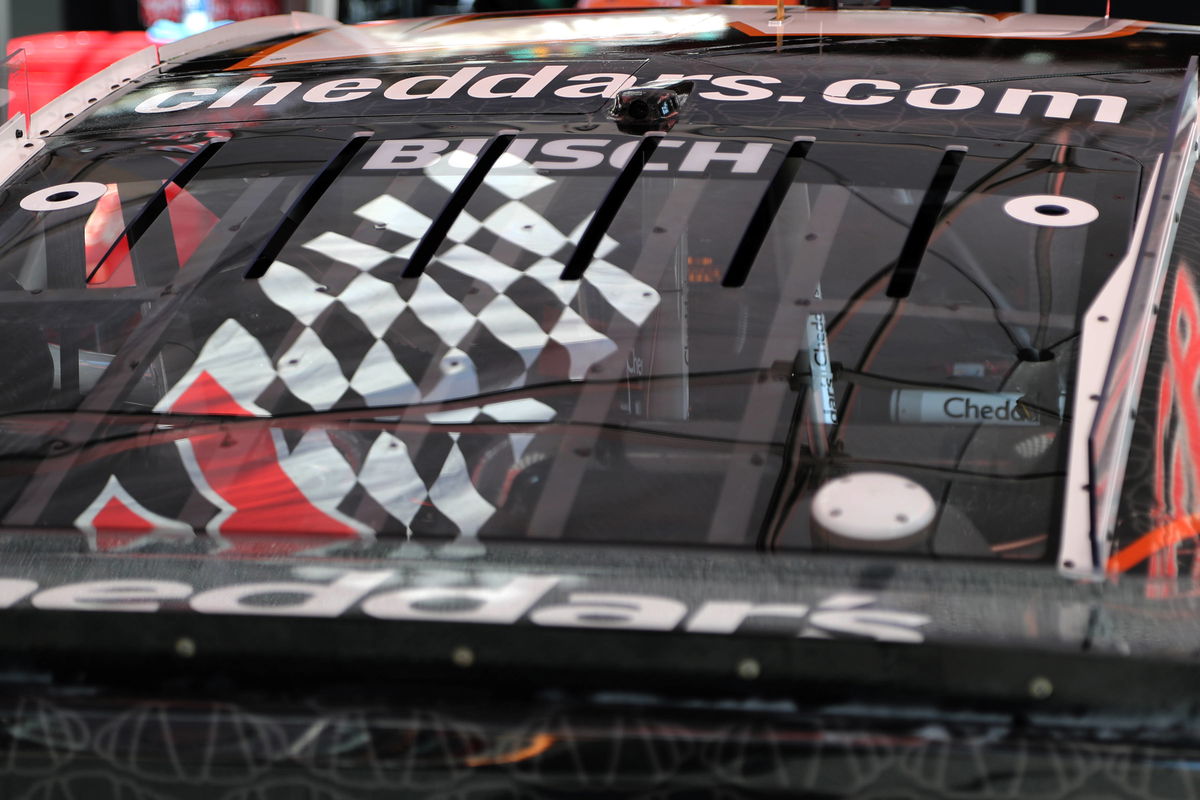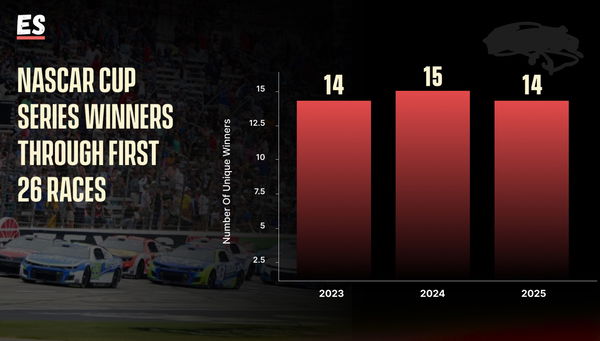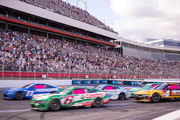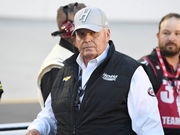
Imago
BRISTOL, TN – SEPTEMBER 20: A checkered flag reflects in the rear winow of Kyle Busch 8 Richard Childress Racing Cheddar s Scratch Kitchen Chevrolet during practice for the NASCAR, Motorsport, USA Cup Series Bass Pro Shops Night Race on September 20, 2024 at Bristol Motor Speedway in Bristol, TN. Photo by Jeff Robinson/Icon Sportswire AUTO: SEP 20 NASCAR Cup Series Bass Pro Shops Night Race EDITORIAL USE ONLY Icon2409201289300

Imago
BRISTOL, TN – SEPTEMBER 20: A checkered flag reflects in the rear winow of Kyle Busch 8 Richard Childress Racing Cheddar s Scratch Kitchen Chevrolet during practice for the NASCAR, Motorsport, USA Cup Series Bass Pro Shops Night Race on September 20, 2024 at Bristol Motor Speedway in Bristol, TN. Photo by Jeff Robinson/Icon Sportswire AUTO: SEP 20 NASCAR Cup Series Bass Pro Shops Night Race EDITORIAL USE ONLY Icon2409201289300
The 2025 Cup Series season has been nothing short of entertaining. With drivers shuffling around the Silly Season to new venues being announced on the calendar for next year, and even the In-Season Challenge, NASCAR has been working hard to keep things interesting for fans. But despite their attempts at making the sport ‘unpredictable’, the same old drivers dominate the headlines.
Watch What’s Trending Now!
On paper, there have been 14 different winners so far, highlighting that the highest level of stock car racing might have finally found an element of ‘parity’ in the sport. But if we take a closer look at the standings, average finishes, and laps led, the statistics paint an entirely different picture altogether. Only 3 teams are running the show.
As expected, Hendrick Motorsports, Team Penske, and Joe Gibbs Racing remain the benchmark. Kyle Larson has already won thrice this season and led a staggering 885 laps with 11 top-five finishes. His teammate, William Byron, won the Daytona 500 earlier this year and has two wins to his name.
ADVERTISEMENT
As for Denny Hamlin, the veteran is proving that age is just a number with four triumphs already, and a seventh-place finish in the opening playoff race at Darlington.
Meanwhile, Christopher Bell, Shane van Gisbergen, and Ryan Blaney also have multiple race wins under their belt. That just goes to show that, despite having a handful of different winners this season, the real control in the Cup Series is held by a small group of elite racers.
ADVERTISEMENT
Drivers in Control
- He might not have entered Victory Lane in the last 15 races, but Kyle Larson remains a force to be reckoned with in the Cup Series. The 2021 champ led a staggering 221 laps at Kansas Speedway earlier this year, sweeping all the stages while using worn-out tires. The No. 5 team works as a cohesive unit, and crew chief Cliff Daniels is as good as it gets atop the pit box.
- William Byron has shown incredible consistency this season and has led 915 laps in 26 races. Even Joe Gibbs Racing has a couple of aces up its sleeves.
- Denny Hamlin continues to defy age, and he recently finished on pole at the 2025 Cook Out Southern 500, the first playoff race of the season. Approaching the twilight of his career, many feel that the 44-year-old’s best chance of lifting the elusive championship is this year, and wins at Martinsville, Darlington, Michigan, and Dover certainly back that intent.
- As for Christopher Bell, the Oklahoman hasn’t reached his early-season heights once again, but nine top-fives highlight his consistency.
ADVERTISEMENT

ADVERTISEMENT
What does it mean for Midfield & Underdogs?
For those further down the grid, the season looks far less promising. Teams like Legacy Motor Club, RFK Racing, and Front Row Motorsports have struggled to break into the top ten regularly, and while we’ve seen Wood Brothers Racing’s Josh Berry enter Victory Lane at Las Vegas Motor Speedway, such results have been few and far between.
Underdog stories have been a part of NASCAR’s heritage for years now, but the gulf between the bigger teams and others is so wide that ‘upsets’ have been harder to find this year.
- To begin with, Kyle Busch is hardly an underdog, considering he’s a two-time Cup Series champion; his last win came at Gateway back in 2023. Going by his circumstances and his 80+ winless streak at the highest level, many wanted ‘Rowdy’ to finally break his winless streak this year. And even though his teammate, Austin Dillon, won at Richmond to qualify for the playoffs, Busch continues to struggle in the No. 8 Chevy.
- Carson Hocevar is another driver who was expected to get his first win this season, and despite some positive performances, Victory Lane has continued to elude him. Still, there have been odd results here and there. Despite his road course prowess, nobody expected Shane van Gisbergen to win four races in his rookie campaign, while Bubba Wallace’s triumph at the Brickyard 400 was one of the most emotional wins of the season.
- Ross Chastain’s surprising Coca-Cola 600 win also sent him into playoff contention.
- Austin Dillon’s triumph at Richmond also made him the first multi-winner at the Cook Out 400 in 15 years. Still, the elite few drivers have continued to dominate the racetrack, and while underdog moments do occur now and again, it’s far too infrequent to satisfy fans.
ADVERTISEMENT
Top Stories
New Charter Deal Triggers ‘Financial Frenzy’ as NASCAR Teams Set for Massive Payday

Rick Hendrick Strikes Fear in NASCAR Fans With Chevy’s New “Illegal” Car

Major Blow to Trackhouse Racing as Team Penske Steals Veteran Crew Chief Back in Unexpected Move

Martin Truex Jr’s Former Crew Chief Ends 12-Year Fight In Huge Personal Announcement

Chevy Team to Enter Kyle Larson’s Series as Michael Jordan Ends NASCAR’s Monopoly

But what is the fan sentiment and cultural echo?
NASCAR fans are divided by the level of competitiveness. Four drivers have won more than three races already, and the playoffs are just beginning. Such results may have contributed to a decline in viewership, as after 26 races, there is roughly a 15% decline, falling from about 3.15 million per race in 2024 to 2.66 million in 2025.
The pivot to Amazon Prime also divided the fanbase, as the streaming service raised the broadcast quality, but alienated some of the older fans. Still, the Coca-Cola 600 saw 2.72 million viewers tuning in, comprising a relatively younger demographic.
ADVERTISEMENT
But, NASCAR paid a big price after pivoting to Prime Video.
- The Great American Getaway 400 saw a 22% drop in viewership compared to last year’s USA Network broadcast, a sign that the digital migration hasn’t gone all too well for the racing series.
- There’s a clear ‘road course fatigue’, with Shane van Gisbergen dominating tracks such as the Autódromo Hermanos Rodríguez, Chicago Street course, Sonoma, and Watkins Glen.
What was supposed to be a break from oval tracks has become far too predictable, with fans mentally checking out quite often halfway through the road course races because of the Kiwi’s dominance.
ADVERTISEMENT
Is the Format to be blamed?
In the Next-Gen era, Team Penske has dominated the Cup Series with three consecutive championship wins, with both Ryan Blaney and Joey Logano taking advantage of the ‘win-and-in’ format. Stage points reward drivers who are already leading races, reinforcing their dominance at the highest level.
However, comes the In-Season Challenge.
ADVERTISEMENT
It has disrupted the status quo in many ways. Ty Dillon eliminated Denny Hamlin in the very first stage, followed by Alex Bowman in the second round. Meanwhile, Ricky Stenhouse Jr. defeated Christopher Bell, and Ty Gibbs knocked out Tyler Reddick. Ultimately, Joe Gibbs’ grandson won the million-dollar prize, an outcome nobody predicted at the start of the competition.
As for the playoff format, 16 drivers qualify for the championship in the last 10 races of the season. For the ‘big’ teams like Joe Gibbs Racing, Hendrick Motorsports, and Team Penske, this usually means all their drivers remain in contention for the Bill France Cup during the business end of the season.
Meanwhile, other teams such as Richard Childress Racing, Spire Motorsports, and RFK Racing are forced to fight for the scraps. That’s a big contrast from other motorsports disciplines like Formula 1 or IndyCar, where there are more frequent underdog wins and a season-to-season shift in winners.
NASCAR needs to level the field
From a technical standpoint, having a broader use of standardized parts can mean some of the smaller teams have a similar setup compared to the likes of Hendrick Motorsports or Joe Gibbs Racing.
1. The sanctioning body can make a deal with manufacturers to eliminate the ‘tier system’, which means all teams under the umbrella of Chevrolet, Ford, or Toyota are treated equally. While that’s easier said than done, and will cause a significant pushback from the big teams, it’s a step that will ensure the smaller teams can compete against the favorites.
Moreover, NASCAR can make restrictor tweaks for superspeedways to reduce the gulf between budget and performance.
2. Having a greater variety of tracks and getting more foreign talent in NASCAR will also help in widening the talent pool in the Cup Series. The sanctioning body can make the Xfinity, Truck, and ARCA Series more sustainable for teams as well, to ensure a healthy pipeline of the next generation of drivers makes their way to the highest level.
And, fans are certain, they want to see ‘Cinderella runs’, like Alan Kulwicki’s famous championship win in 1992 for AK Racing.
Conclusion
Ultimately, dominance builds dynasties. Just look at the Earnhardt family. Fans want to see future Hall of Famers like Kyle Larson and Denny Hamlin tear up the racetrack and show their dominance at the highest level. But such performances shouldn’t take away the element of ‘unpredictability’ of the Cup Series, as that’s what sets NASCAR apart in the first place.
Fans want to feel that every Sunday, a lesser-known driver or a smaller team can compete for the win, and that’s an aspect the sport cannot afford to lose.
And, if the 2025 season is anything to go by, it’s a warning sign for fans that the competitive balance is fading, and small teams will only remain fillers at the highest level, while the big names continue to thrive.
ADVERTISEMENT
ADVERTISEMENT
ADVERTISEMENT

